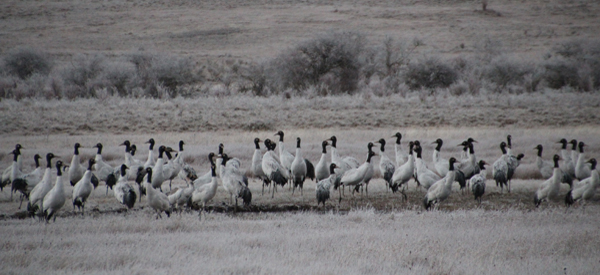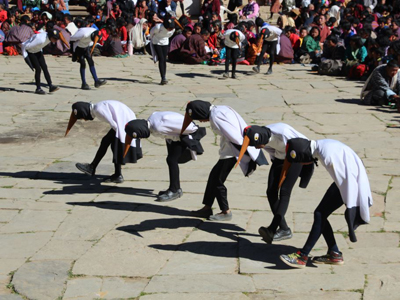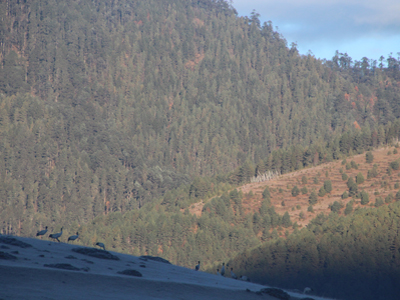
Black-necked Cranes at dawn at their roost in Phobjika Valley, Bhutan, November 20, 2013.
By Dr. George Archibald, ICF Co-founder & Senior Conservationist
A Glimpse of the Black-necked Cranes in Bhutan
 Since late October, the numbers of Black-necked Cranes in the Phobjika Valley, Bhutan have increased as more birds made their migration over the Himalayas. By November 11, the date of the Fourth King’s Birthday and of the Crane Festival within the courtyard of the Gangtey Gompa (16th century Buddhist temple), there were 262 (right, detail of the crane dance performed at the festival). When I returned on November 19, there were about 350, about 10 percent of which were juveniles, an indication that all is well on the breeding grounds in Tibet. More cranes are expected. Last winter the highest count in the valley was 368. This winter we hope the number exceeds 400!
Since late October, the numbers of Black-necked Cranes in the Phobjika Valley, Bhutan have increased as more birds made their migration over the Himalayas. By November 11, the date of the Fourth King’s Birthday and of the Crane Festival within the courtyard of the Gangtey Gompa (16th century Buddhist temple), there were 262 (right, detail of the crane dance performed at the festival). When I returned on November 19, there were about 350, about 10 percent of which were juveniles, an indication that all is well on the breeding grounds in Tibet. More cranes are expected. Last winter the highest count in the valley was 368. This winter we hope the number exceeds 400!
Late in the afternoon of November 18, Jigme Tshering, an employee of the Royal Society for the Protection of Nature (RSPN) and the Field Coordinator of RSPN’s crane research and conservation programs, and his assistant, Santa, and I constructed a tiny hide from five stakes and five odd shapes of plywood scraps at the base of the grassy hill that bordered the nighttime roosting area of the cranes. In front of the blind were two shallow ponds – one natural and the other made by Jigme and his colleagues to provide more open water in which the cranes might stand through the night.
A few years ago infrared camera traps provided that leopards killed cranes at the roost, presumably because the natural pond could not accommodate all of the birds. Those standing on drier areas beside the pond were apparently more susceptible to predators that could sneak across dry ground much easier than across water. To provide more safe roosting areas, in summer while the cranes were breeding in Tibet north of the mountains, the Bhutanese unearthed a layer of soil from the marsh and used the pile lings to create a dike to hold water in the excavated area. It worked. In subsequent winters the loss of birds to predators was greatly reduced.
With just one early morning available for me to experience cranes at Phobjika, we hoped that by entering the hide before the first light of dawn, we would be able to study and photograph the cranes at close range.
After the hide was standing, I climbed a nearby hill, and from behind a pile of rocks, watched the cranes until dark. In late afternoon I could see three major flocks of cranes numbering about 100, 80 and 60 respectively in three different areas of the valley floor. Adult-plumaged cranes in contrasting black and white far outnumbered a few juveniles with lighter necks and darker bodies in the flocks. In addition, I counted about a dozen families of cranes (pairs with one or two juveniles) widely scattered around the valley.
Long after the western hills blocked direct sunlight from the valley floor but just before total darkness, first the families and then the flocks landed near the two ponds. The arrivals were followed by bouts of loud duets of mated pairs, the unison call, as dominance hierarchies were established and the cranes arranged themselves within the confines of the roost. We wondered if the more dominant pairs might secure more central and perhaps safer shallows. When we returned to our roost in a cozy hotel on the opposite side of the valley, unison calls continued to lift from the valley floor. But later in the light of a full moon, there was silence. Cranes rested.
 Excited by the thought of being close to the cranes at dawn, I awakened at 2:00 a.m. Jigme did the same an hour later. At 4:00 a.m. we departed to the blind. From the edge of the forest on the hill behind the roost, in the moonlight we began our descent to the blind that stood near the roost. With Jigme close behind me, in tiny shuffling steps we slowly moved as one down the hill toward the blind, concerned at the cranes might detect us. In the moonlight, perhaps we looked like a bush and because our progress was so slow, the cranes remained silent.
Excited by the thought of being close to the cranes at dawn, I awakened at 2:00 a.m. Jigme did the same an hour later. At 4:00 a.m. we departed to the blind. From the edge of the forest on the hill behind the roost, in the moonlight we began our descent to the blind that stood near the roost. With Jigme close behind me, in tiny shuffling steps we slowly moved as one down the hill toward the blind, concerned at the cranes might detect us. In the moonlight, perhaps we looked like a bush and because our progress was so slow, the cranes remained silent.
From 5:00 a.m. to 7:00 a.m. I was on my knees behind a small camera perched on my tripod, with Jigme sitting beside me on an upturned plastic bucket. We covered ourselves with a brown blanket loaned from the hotel, so the cranes could not detect movement within the hide. A dark streak of the frost-covered marsh eventually revealed a flock of resting cranes.
It was not until the valley was illuminated to some extent by dawn that cranes started to depart. The pairs with juveniles were first, each flying in a path leading to their daytime feeding territories. Flocks of cranes without chicks were the last. All had departed before we stood up and stretched. We both had a degree of hypothermia, so we welcomed a vigorous walk back up the hill and on to our breakfast (above, cranes in the shadows as the dawn lights the forested hillside of Phobjika Valley).
